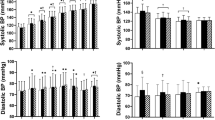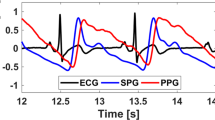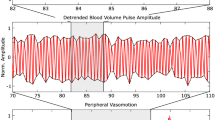Abstract
Exercise induced hemodynamic stress has been studied extensively using a wide range of physiological sensors. While athletes can modulate their training intensity using EKG-based heart rate monitors, there are currently no noninvasive monitors that can be used to ascertain with a high degree of certainty the hemodynamic stress an individual is experiencing because of fatigue or an underlying pathology. We propose that cardiac stress will result in detectable changes in skin blood flow. In a clinical trial with eleven healthy subjects performing the Bruce Protocol treadmill test low frequency waves were observed in the blood flow to both the forehead and ear, but not the finger, using photople- thysmographs (PPG) measured by a pulse oximeter. As volitional fatigue approached, the low frequency (f = 0.05–0.2 Hz) amplitude modulation observed in the PPG became more pronounced; then, within several seconds of the cessa- tion of the protocol, they disappeared. Using a software-based detector, these distinct waves are reliably detected, with a low incidence of false positives, in all subjects before the onset of volitional fatigue. We hypothesize that the low frequency waves observed in the PPG of individuals exercising to volitional fatigue provide a mechanism for noninvasively detecting hemodynamic stress to the human vascular system.
Similar content being viewed by others
References
Astiz ME, Rackow EC. 1993 Assessing perfusion failure during circulatory shock. Crit Care Clin 9:299–312
Kales SN, Soteriades ES, Christoudias SG, Christiani DC. Firefighters and on-duty deaths from coronary heart disease: a case control study. Environ Health 2003; 2
Ho CW, Beard JL, Farrel PA, Minson CT, Kenney WL. 1997 Age, fitness, and regional blood flow during exercise in the heat. J Appl Physiol 82:1126–1135
Fritzsche RG, Coyle EF. 2000 Cutaneous blood flow during exercise is higher in endurance-trained humans. J Appl Physiol 88:738–744
Bernardi L, Hayoz D, Wenzel R, Passino C, Calciati A, Weber R, Noll G. 1997 Synchronous and baroceptor-sensitive oscillations in skin microcirculation: evidence for central autonomic control. Am J Physiol Heart Circ Physiol 273:H1867–H1878
Ditor DS, Kamath MV, MacDonald MJ, Bugaresti J, McCartney N, Hicks AL. 2005 Effects of body weight-supported treadmill training on heart rate variability and blood pressure variability in individuals with spinal cord injury. J Appl Physiol 98:1519–1525
Gratze G, Rudnicki R, Urban W, Mayer H, Schlögl A, Skrabal F. 2005 Hemodynamic and autonomic changes induced by ironman: prediction of competition time by blood pressure variability. J Appl Physiol 99:1728–1735
Sergueef N, Nelson KE, Glonek T. 2004 The effect of light exercise upon blosod flow velocity determined by laser-doppler flowmetry. J Med Eng Technol 28:143–150
Jankel WR, Niedermeyer E. 1985 Sleep spindles. J Clin Neurophysiol 2:1–35
Madwed JB, Albrecht P, Mark RG, Cohen RJ. 1989 Low-frequency oscillations in arterial pressure and heart rate: a simple computer model. Am J Physiol Heart Circ Physiol 256:H1573–H1579
Wray DW, Fadel PJ, Keller DM, Ogoh S, Sander M, Raven PB, Smith ML. 2004 Dynamic carotid baroreflex control of the peripheral circulation during exercise in humans. J Physiol 559:675–684
Shamir M, Eidelman LA, Floman Y, Kaplan L, Pizov R. 1999 Pulse oximetry plethysmographic waveform during changes in blood volume. Br J Anaesth 82:178–181
Mohrman DE, Heller LJ. 2003 Cardiovascular physiology, 5 ed. New York: McGraw-Hill/Appleton & Lange
Gesquiere MJ, Awad AA, Shelley KH, Stout RG, Silverman DG. Can ear plethysmography detect moderate blood loss in healthy, non-intubated volunteers? Anesthesiology 2004; 101: A180
Nilsson L, Johansson A, Kalman S. 2003 Macrocirculation is not the sole determinant of respiratory induced variations in the reflection mode photoplethysmographic signal. Physiol Meas 24:925–937
Kellogg DL, Johnson JM, Kenney WL, Pbrgola PE, Kosiba WA. 1993 Mechanisms of control of skin blood flow during prolonged exercise in humans. Am J Physiol 265:H562–H568
Halliburton WD. 1919 Traube waves and mayer waves. Exp Physiol 12:227–229
Nilsson H, Aalkjær C. 2003 Vasomotion: mechanisms and physiological importance. Mol Intervent 3:79–89
Roman JAS, Vilacosta I, Castillo JA, Rollan MJ, Hernandez M, Peral V, Garcimartin I, de la Torre MdM, Fernandez-Aviles F 1998 Selection of the optimal stress test for the diagnosis of coronary artery disease. Heart 80:370–376
Linder SP, Wendelken SM. Using the morphology of the photoplethysmogram envelope to automatically detect hypovolemia, presented at IEEE CBMS, 2006
González-Alonso J, Calbet JAL, Nielsen B. 1998 Muscle blood flow is reduced with dehydration during prolonged exercise in humans. J Physiol 513:895–905
Hanson P, Claremont Alan, Dempsey J, Reddan W. 1982 Determinants and consequences of ventilatory responses to competitive endurance running. J Appl Physiol 52:615–623
Chouraqui P, Schnall RP, Dvir I, Rozanski A, Qureshi E, Arditti A, Saef J, Feigin PD, Sheffy J. 2002 Assessment of peripheral artery tonometry in the detection of treadmill exercise-induced myocardial ischemia. J Am Coll Cardiol 40:2195–2200
Charkoudian N (2003) Skin blood flow in adult human thermoregulation: how it works, when it does not, and why. Mayo Clin Proc 78:603–612
Nadel ER, Cafarelli E, Roberts MF, Wenger CB. 1979 Circulatory regulation during exercise in different ambient temperatures. J Appl Physiol 46:430–437
Wilkins BW, Minson CT, Halliwill JR. 2004 Regional hemodynamics during postexercise hypotension. Ii. Cutaneous circulation. J Appl Physiol 97:2071–2076
Mack GW, Cordero D, Peters J. 2001 Baroreceptor modulation of active cutaneous vasodilation during dynamic exercise in humans. J Appl Physiol 90:1464–1473
Arens E, Zhang H. The skin’s role in human thermoregulation and comfort. In: Pan, N, Gibson, P, eds, Thermal and moisture transport in fibrous materials. Woodhead Publishing Limited, Cambridge, England, 2006: 560–602
Cabanac M. 1993 Selective brain cooling in humans. FASEB J 7:1143–1146
Podgoreanu MV, Stout RG, El-Moalem HE, Silverman DG. 2002 Synchronous rhythmical vasomotion in the human cutaneous microvasculature during nonpulsatile cardiopulmonary bypass. Anesthesiology 97:1110–1117
Author information
Authors and Affiliations
Corresponding author
Additional information
Linder SP, Wendelken S, Clayman J, Steiner PR. Noninvasive detection of the hemodynamic stress of exercise using the photoplethysmogram.
Rights and permissions
About this article
Cite this article
Linder, S.P., Wendelken, S., Clayman, J. et al. Noninvasive Detection of the Hemodynamic Stress of Exercise Using the Photoplethysmogram. J Clin Monit Comput 22, 269–278 (2008). https://doi.org/10.1007/s10877-008-9129-9
Received:
Accepted:
Published:
Issue Date:
DOI: https://doi.org/10.1007/s10877-008-9129-9




